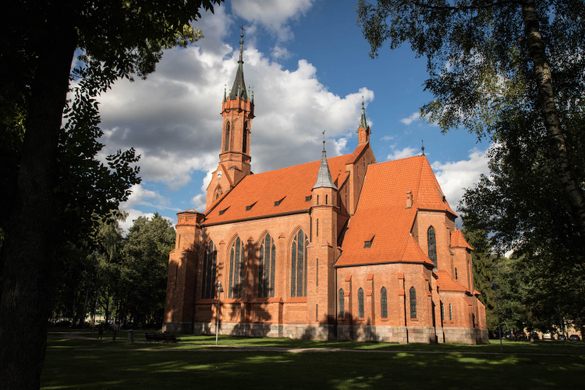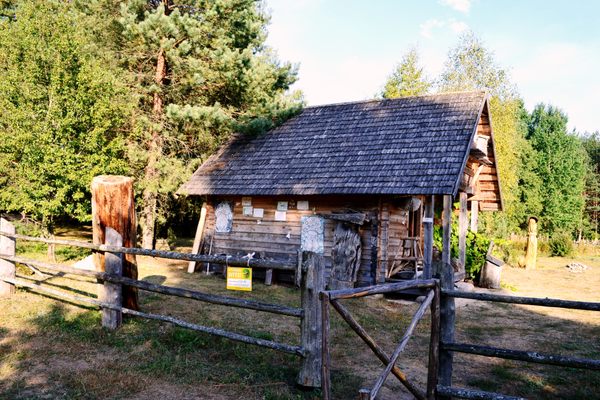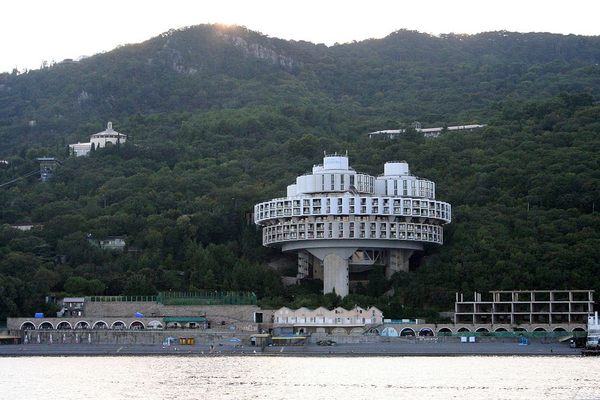Hotel Pušynas
This striking structure is the Socialist-modernist centerpiece of a former Soviet spa resort.
The town of Druskininkai, located in southern Lithuania not far from the borders with Belarus and Poland, was first mentioned in 1636. Its name derives from the Lithuanian word for “salt,” “druska,” owing to the rich mineral content of the local waters. By the 18th century, people were already traveling to Druskininkai to find cures for ailments such as asthma. In the early 19th century, the Lithuanian professor Ignacy Fonberger published his analysis of the healing water, which was shown to be rich in minerals such as potassium, calcium, iron, sodium, magnesium and iodine.
In 1837, Tsar Nicholas I of Russia bestowed the title of “spa town” on Druskininkai. In 1862, the town was connected by rail, on the Warsaw-Saint Petersburg line. Before long, it was receiving not only convalescents, but had also become a desirable summer residence for the Polish, Lithuanian, and Russian middle classes.
This spa culture flourished during the later Soviet period. The Soviet Union had a penchant for sanatoriums and health resorts. Lenin himself had been a strong advocate, and the 1922 Labor Code dictated that all Soviet workers should spend at least two weeks per year making use of the nation’s sanatoriums. Druskininkai, on the Nemunas River, was promoted as a prestigious health retreat for Soviet citizens traveling from Lithuania or Belarus. By the mid-20th century, its classical-styled tsarist-era health resorts were being complemented by the appearance of Soviet Modernist sanatoriums and spa hotels. At its peak popularity, Druskininkai received as many as 400,000 annual visitors, who traveled here from all corners of the Soviet Union.
Hotel Pušynas was perhaps the most striking of Druskininkai’s Soviet-era spa hotels. This 66-room hotel was opened in 1982 under its original name Sūrutis Sanatorium. The building’s architects, R. Šilinskas and N. Kėvišas, intended for the cylindrical building to resemble a huge, concrete pine cone. Later, the hotel would change its name to “Pušynas,” meaning “Pine Forest.”
When a newly-independent Lithuania began its movement towards de-Sovietization, many of the nation’s Soviet leftovers ended up being quarantined in Grūtas Park, a memorial garden just six miles from Druskininkai, which has become a repository for outdated political monuments. Druskininkai itself is changing too, with the appearance of new, contemporary health resorts, popular restaurant chains, and a growing population. As such, while Hotel Pušynas is far from being the only remaining Soviet-era retreat in Druskininkai, its extraordinary Socialist-modernist architecture nevertheless sets it apart as perhaps the most striking visual representation of Druskininkai’s 20th-century Soviet spa heyday.
Know Before You Go
Hotel Pušynas is a working spa hotel. It is located in the center of Druskininkai, close to the Neo-gothic Church of St. Mary’s Scapular. The town itself is a two-hour drive from Vilnius, the Lithuanian capital, and could easily be combined with a visit to the nearby Grūtas Park.


















Follow us on Twitter to get the latest on the world's hidden wonders.
Like us on Facebook to get the latest on the world's hidden wonders.
Follow us on Twitter Like us on Facebook